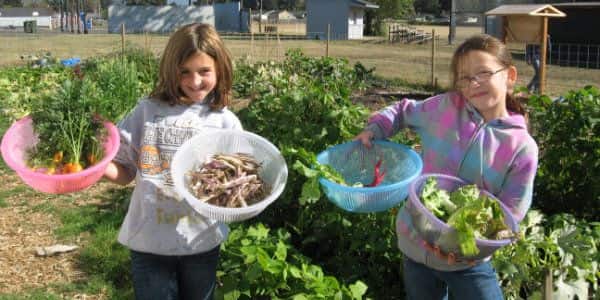During Spring Break 2013, East Elementary and Tillamook Junior High School hosted nine student volunteers from Reed College in Portland, Oregon, for an “alternative spring break” service program, which was facilitated by their community partner Food Roots.
In just one week, this small group of volunteers donated approximately 200 hours of labor to the two school gardens—the equivalent of one person working full-time for five weeks!
A growing number of college students are trading partying for productivity and seeking out spring break service projects to earn class credits, conduct research or build their resumés. It’s a trend that school garden programs everywhere can benefit from since March is just the time of year when garden labor needs ramp up.
The rural community of Tillamook is home to more cows than people and more than half of students in the county qualify for free or reduced lunch. Although students at East Elementary and Tillamook Junior High have access to a robust garden program, finding enough helping hands is an ongoing challenge.
“Since our community relies on tourism for much of its economy, finding able-bodied, available volunteers, during holidays, summer and spring break is pretty challenging,” says Shelly Bowe, director for Food Roots, a local organization that operates the gardens at both schools. Food Roots is part of the national FoodCorps project and works closely with the Oregon Department of Agriculture Farm to School Program. “When Reed College contacted us about an alternative spring break program, we immediately embraced the idea.”
“When Reed College contacted us about an alternative spring break program, we immediately embraced the idea.”
The perfectly timed opportunity also came on the heels of a recent expansion funded by a 2012 Whole Kids Foundation garden grant, which created a new 3,150-square-foot garden at East Elementary School and expanded the garden across the street at Tillamook Junior High.
Reed College students handled several large projects, including reorganizing the greenhouse, defining and prepping garden beds, and building and roofing a display kiosk.
“Accomplishing these types of infrastructure projects with grade-school kids doesn't work very well,” Shelly says. “The repetition and heavy work gets old with the kids pretty fast. We’re also limited in the type of tools younger kids can use. This was such a success, we plan to do it again.”
When the college-age volunteers weren’t hard at work in the gardens, Shelly and her team took them on tours of the local landscape, including a farm, a food bank, a fishing village, community gardens and a local restaurant and brewery.
“The planning took about three months,” Shelly says. “We had to come up with housing and a local church stepped up to offer rooms at one of their facilities. We created a detailed itinerary and activity sheets outlining each project.”
In addition to productivity in the garden, new connections were made and these urban students enjoyed a taste of rural life while doing something good in the world.
Top 5 Tips for Hosting an “Alternative Spring Break” Service Program
- Reach out to universities and junior colleges in your region, especially those in urban environments where students may be eager for a taste of rural life.
- Begin planning at least 2-3 months in advance. Outline your garden needs and create a schedule for what will be accomplished each day. Include activities and tours that provide learning experiences for the volunteers.
- Break the garden work into projects. Create activity sheets for each project clearly outlining the steps, materials and tools needed. Assign the appropriate number of people and a team leader for each task.
- Create a budget. Seek out sponsors from the community and consider how you will provide housing and transportation if needed.
- Have a weather backup plan. In many regions, March temperatures can swing either way. Plan something productive for volunteers to do in the event of inclement weather.



